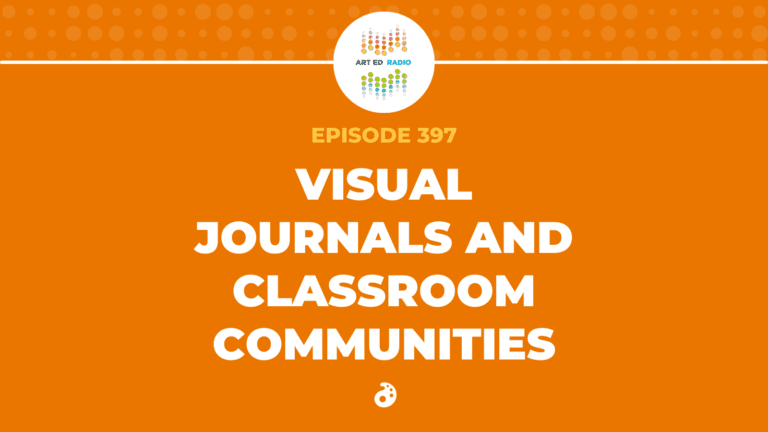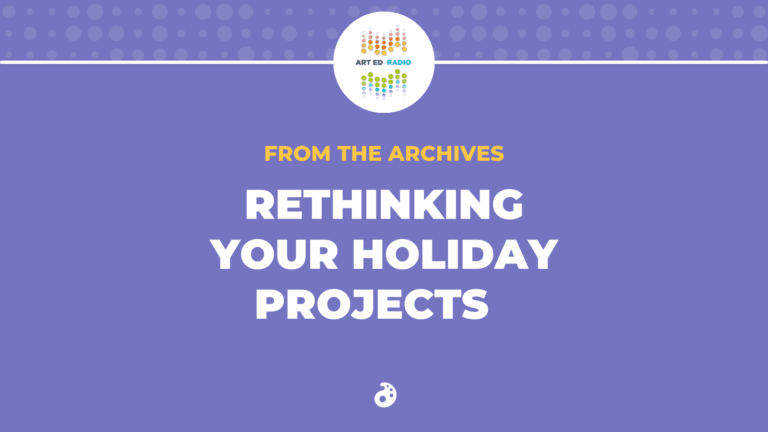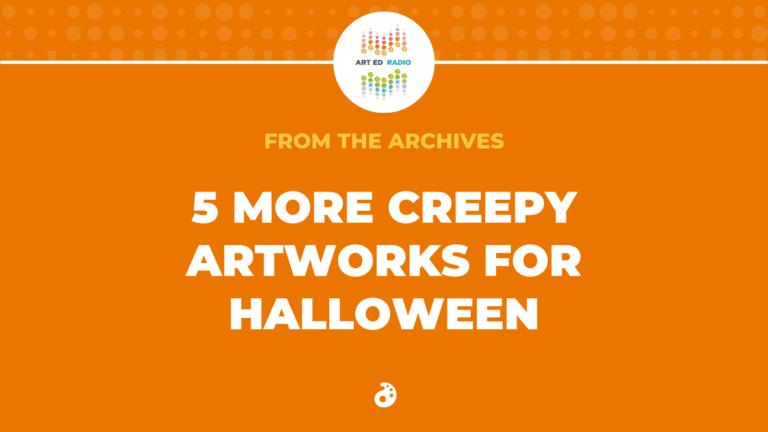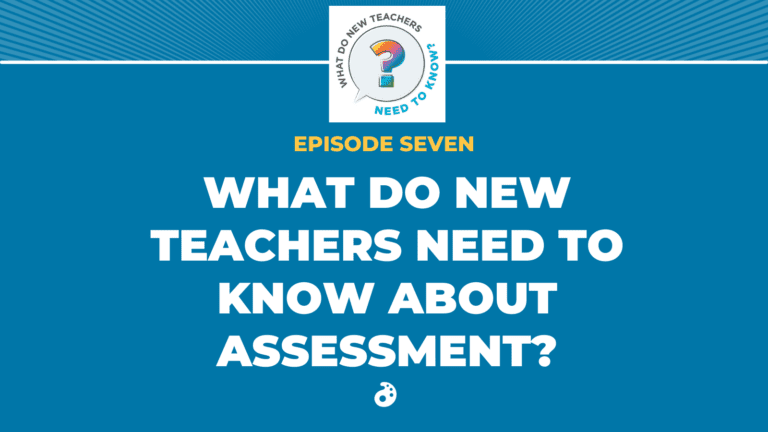It is a big day at The Art of Education University today, as we announce our newest offering–FLEX Curriculum. AOEU’s Director of K-12 Curriculum, Cassidy Reinken, joins Tim to talk all about FLEX. Listen as they discuss how the platform meets and adapts to teachers’ needs, and how FLEX helps them plan and deliver the perfect curriculum for their students. Full Episode Transcript Below.
Resources and Links

Transcript
Tim: Welcome to Art Ed Radio, the podcast for art teachers. This show is produced by The Art of Education University. I’m your host, Tim Bogatz.
Today is a very exciting day for The Art of Education University because we are launching our FLEX curriculum offering. Now, this is a new product that has been in development for a couple of years now. We’ve been working behind the scenes so hard on everything that’s involved with this. We teased it out a little bit at the Art Ed Now Conference on Saturday. You may have seen that, but we are ready to debut it to the world. Our director of K-12 curriculum, Cassidy Reinken, is going to join me in just a little bit to talk about everything that FLEX involves.
Let me give you just a rundown really quickly, because over the years we have heard from hundreds, if not thousands, of our teachers who keep saying, “There is a desperate need for a new curriculum solution. When are you guys going to have a curriculum? When are you going to have these materials that we can purchase?” Lesson plans is the most common search term on our site, and it is year after year after year, because putting together a curriculum, or multiple curriculums, depending on how many grade levels and how many classes you teach, it’s incredibly time-consuming. Our thought here is that if we can provide a curriculum for you, then you have more time that can be spent on student instruction or classroom management or whatever else you need to be doing to make your classroom run better, to make yourself a better teacher.
As we’re thinking about how to give people more time, how to provide that curriculum, we decided that we needed to build a modern flexible curriculum, and as always, it’s specific for art teachers. There is so much there allowing you to build your own curriculum, because there is just a huge library of lessons and resources and just a ton of vetted curriculum materials. You can go in there and pick out the lessons you like, the resources you want to use, the videos you can show to the kids, the assessments that you don’t want to write yourself. All of those things are available in the curriculum.
It’s something that you definitely want to check out. It is live on the site as of today. If you go to theartofeducation.edu/flex, then you can get a peek at what’s there, and it will give you some ideas on how to get this curriculum for your district, how to talk to your administrator about that, how to get our team in touch with your administrators. Again, theartofeducation.edu/flex. Make sure you check it out, but until you do, let’s bring on Cassidy and we will have a little bit more of a conversation about everything that FLEX involves.
All right, Cassidy Reinken is joining me now. Cassidy, how are you today?
Cassidy: I’m doing great. Thanks for having me. I’m really happy to be a guest on Art Ed Radio.
Tim: Well, we are happy to have you. We are excited about FLEX launch. This is an amazing curriculum. But I want to begin with this. Can we talk about how you came to be director of curriculum at AOE U? You were an administrator at a STEAM school, you had a great job doing something you loved, and you decided to come here to AOEU to develop the FLEX curriculum. I guess the question is, what made you believe in AOEU, and believe in FLEX in particular, that much?
Cassidy: Yeah, sure. My heart has always been with AOEU since I started as one of the first writers for the magazine, and I was a graduate instructor. I left AOEU to dedicate time, basically, to be in a leadership position, as you mentioned, and to open a brand new magnet school in our school district. It was a unique situation. At that same time, I was starting a master’s program, so it was just really busy and I decided that I needed to focus on those two roles, so I left AOEU. After four years in that role, I circled back, and I am here now.
I believed in AOEU because of the mission and basically the impact that they’re making on teachers and student learning. For me, my mantra has always been growth and impact. As a lifelong learner, I continually am focusing on growth and impact as an important part of living, and so when I looked at this opportunity, I looked at FLEX curriculum, and the impact and the growth that it could make on teachers and student learning, on myself in a new challenging role, I stepped into this role and just took it on, the challenge of developing an innovative art curriculum. It was just a really good time, and it has been an amazing roller coaster, amazing team effort. I am so proud of FLEX curriculum and everything that we have to show you.
Tim: Yeah, that’s awesome. I don’t know, that’s a lot of, I don’t know, inspiring words, I suppose. I love the mantra and I love the focus you have on everything we’ve put into this curriculum. I wanted to have you introduce the curriculum and talk a little bit about how it works. We did a little sneak preview at the conference on Saturday, but can you explain a little more about what’s available and all the different resources that are in the curriculum, how it can be used in the art room?
Cassidy: Yeah, sure. We have what is called collections, and currently we’re going to launch with 36 collections. Collections are really just a grouping of resources and lesson plans and videos and assessments that are all around a certain theme. We have a wide variety of themes, things such as Contrast through Color, Literacy through Storytelling, Emotion and Identity, Simple Landscapes, and so much more.
The best thing about these collections is you can filter them down. There’s lots of different views in FLEX. You can imagine them as libraries, and these filters then take all of these resources and content and materials and narrow it down to your search. It’s really about personalizing based on what you need. The collections each have anywhere from five to six lesson plans right now, resources, videos and assessments, and then you can basically create your own units based on those documents.
I think my favorite thing about it is just the variety of collections. I love that even though there’s three different levels in a collection… We have Beginner, for K through five standards alignment, Intermediate are for sixth through eighth grade standards, and then Advanced is ninth through 12th grade standards. I love that even though I can see an Advanced lesson in a collection, if I was an elementary teacher or a middle school teacher, I could look at that lesson and I could modify it for my students. It really is filled with so many ideas and high-quality content that can be used in all the classrooms.
Tim: Yeah, absolutely. I don’t know, that’s one of the things that in my classroom, I always try to do. I would find inspiration from wherever and then just try and make it my own. I think that, like you said, FLEX is so… There are so many different ideas that you can take, you can adapt, that you can make your own. I think that’s a really, really good thing about it.
Now, I wanted to ask you, though, now that FLEX has been launched, you maybe have had a minute to relax. I don’t know. But I would love for you to share what people are saying to you about what we’ve put together, some of the early feedback that you’ve been getting. What are you hearing from teachers and administrators and school districts about FLEX?
Cassidy: Yeah, we’ve had the opportunity to show FLEX to a variety of teachers and school districts and administrators, and they are all very impressed. Of course, teachers absolutely love it. They say things like, “Where was this 10 years ago when I was starting?” or “I could use this right now. How do I get it?”
Administrators really like the ability to have access to a high-quality art curriculum, because many administrators, art maybe isn’t something that they’re as familiar with and they might not know how to coach an art teacher. They might not know what a curriculum even looks like for art. This really creates this communication platform, that administrators have the tools that they need in FLEX curriculum and teachers have what they need, and they can work together then to really focus on student learning.
Then I think school districts, they really like the idea of how curriculum dollars can be used for FLEX curriculum, because this is something that school districts have been looking for, a solution to art education, and just haven’t found the right product because a lot of districts are moving away from traditional textbooks, many are going to open education, they’re going to creating their own lesson plans, and so this is a great comprehensive way that they can support all teachers in their district. It really creates equity and access across the district.
Tim: Yeah, I think that’s really good. I think the equity and access point is key, especially for a little bit bigger districts. I think that works well for them. I want to ask you something, though, because as you were just going through everything that’s in there, I was thinking back to when I had to write curriculum. A couple things you said hit home with me because, like you said, 10 years ago, where was this? When I was writing curriculum, there was nothing available. I had a few lessons written for me that I didn’t like, very few supplemental resources, and like you said, with the textbooks, I had them, my district spent God knows how much money, and they literally just sat on the shelf because most art teachers don’t want to use textbooks. Can you talk a little bit more about how FLEX moves away from that model, and I guess what it does better than what’s out there already?
Cassidy: Yeah. It moves away from a traditional textbook model, because a textbook, you buy and you often keep for seven years, maybe 10, some districts I’ve known to have 20-year-old textbooks, and the content in it is static. You have those lessons, and those are your lessons that you use. With FLEX, the content is dynamic. We are releasing new collections on a monthly basis. Because we have such an amazing community, like the listeners of this podcast and everyone who reads the magazine and takes classes, we can pivot and we can provide new information that is real world, that our readers and students are asking for. We can release content that is meaningful, and it’s modern and it’s up to date, and it gets engagement increased, and it really supports teachers in what they need when they need it. I think that’s really one of the most powerful things about FLEX.
Another thing is a lot of curriculums that you may purchase are aligned to standards. Sometimes they’re not, depending on where you find a lesson. FLEX curriculum is not only aligned to standards, but it’s filtered by standards. If you can imagine a library of over 400 high-quality resources that an amazing graphic design team created, we can filter those down by things such as media, we can filter it by elements and principles, subject, theme, connections, and we can narrow it down to get what you need when you need it. Then you can also filter it by standards. If I knew I needed to find a lesson for responding standard, I can literally filter my lessons based on that standard.
The best part yet is there are lots of states across the country who have their own visual arts standards, and so our team is aligning FLEX lessons and select resources to those state standards. This is game-changing for a curriculum because it also is providing equity and access to all of these states who don’t use the National Core Arts Standards. We’re trying to really bring it down to the individual art teacher and give them what they need, regardless of how they teach, how long they’ve been teaching, and where they teach.
Tim: Yeah, that’s amazing. I guess, just to be clear, so if I’m in Colorado, for example, and I want to do things based on Colorado state standards, I can just filter through there and it’ll bring up everything that meets a particular standard?
Cassidy: Yeah. The content that is aligned to standards will be aligned to Colorado state standards. You have it.
Tim: That’s amazing. Then also if I’m looking for a third-grade painting lesson, I can just filter for Beginning Painting and it’ll bring up everything that’s available for that too?
Cassidy: Yeah. Yep. The content, I mentioned earlier it’s three different levels. We have Beginner, Intermediate, and Advanced. The Beginner is actually in two different grade bands. It’s K-2 and 3-5. If you were looking for third grade, you could use that filter and you could find lessons that were aligned to the third through fifth grade standards. The beautiful thing about standards is they build off of each other.
Let’s say that actually I found an Intermediate lesson that I wanted to use in my third-grade classroom in Colorado. I could then look at my standards and figure out what standard was a third-grade standard if I needed to hit that. I think that’s what art teachers are so good at. We’re creative. We are so used to finding all of these resources and making our own curriculum, really. FLEX really sticks with that philosophy of not saying, “Okay, turn page seven. This is a line lesson. On page nine, now it’s a shape lesson. On page 11, now it’s a color lesson.” It’s really about you being the artist and the curator of your curriculum and learning experiences.
Tim: Yeah, that’s perfect. Like you said, it’s a game-changer to be able to adapt that to your kids and what’s going on in your classroom, as well as your interests as a teacher. That’s awesome.
Now, let me just ask you personally, what are your favorite parts of the FLEX curriculum? Between lessons, assessments, animated videos, resources, what are you most excited about when you look at everything that’s there? I’m sorry to put you on the spot there.
Cassidy: Darn it. It all? All of it. I would say I think the videos are amazing. Not only is the narrator awesome-
Tim: I know.
Cassidy: Tim narrates some of the videos. Nic Hahn narrates some of the other ones. But I loved using short videos in my classroom, and that was something where I just spent a lot of time finding them. There were a couple of really great ones, but they were like 30 minutes, or I would go on YouTube and I just always was afraid of what would show up.
Tim: Or even if you found something good, it’s usually just boring. Anyway, select them anyway-
Cassidy: Yeah. These videos are created by The Art of Education University. We have an amazing team of designers. They’re three minutes to five minutes, and it’s just a perfect way to introduce a concept or to circle back to a concept, that you’re teaching color and you’re like, “Hey, let’s get a refresher on this color,” and show the video. I think that those are going to be a really great addition to the classrooms.
Then also just the resources. I spent so much time when I was teaching, making an exit slip or making a document for an artist statement. The artists’ biographies are just beautiful, and just a really quick way that kids could access them. I think that if I had to pick, I’d pick videos as number one and resources as number two maybe. There’s probably a tight tie, but yeah.
Tim: No, that’s good. I’m partial to the videos, just because I worked on them. I think they’re spectacular. But there’s so much good stuff.
We probably need to get out of here soon, so let me just ask you, finally, just any words of advice for the early adopters? People who have already subscribed to FLEX, where’s a good place to start when they’re checking things out? What would you recommend diving into when you first get into the platform?
Cassidy: I highly recommend going to the Implementation page. That is really everything about FLEX. It looks like a lot of documents, and I just suggest that you spend some time there reading that and figuring out, what can we do to help you so you’re successful in implementing FLEX?
Read those documents, then just start playing around with it. Make your own classes. Design a unit. Use those filters. Try and find something. Even if you picked one lesson or one resource or something to try, I think that’s the best way, is just jump in, pick something, and then use it.
Say, “Okay, next week, I’m going to pick one resource, and I’m going to use it in two of my classes.” Even if it’s an exit slip that’s the same exit slip, just try something new and start to implement it, because if you’re like me, you get a subscription and you might not use it right away. I just encourage you to just jump in and pick something and try it with your students.
Tim: Yeah, I think that’s awesome advice. Well, Cassidy, we will wrap it up there. Thank you so much for joining me. Congratulations on finally getting FLEX launched. I know it’s been a huge undertaking, and it’s awesome to see it out in the world. Thank you and congratulations.
Cassidy: Thank you. Bravo, team. Have a great day yourself.
Tim: All right, thank you so much to Cassidy for coming on and just telling us all about FLEX, everything that’s gone into it and everything that’s available for you now. Like she said, it’s a game-changer, being able to search by standards or by grade level or by media, or by all of the above if you need to. Just seeing everything that’s out there is huge. It’s everything that you need to design a curriculum that caters to what you want to teach, caters to your students’ interests and provides them the opportunity to make art with choice and voice. It’s not a canned curriculum. It’s not a static curriculum. It’s something that you want to use. It’s things that your kids are going to want to do.
I definitely encourage you to check it out. Again, just go to theartofeducation.edu/flex to check everything out, see everything that’s available, and see if it’s going to work for you and your classroom. As we said in the beginning, having this curriculum available, having those things done for you is absolutely a huge advantage when it comes to giving you more time, and that’s time that, like we said, can be spent on classroom management or instructional strategies or whatever else you need to do to improve your teaching.
Art Ed Radio is produced by The Art of Education University, with audio engineering from Michael Crocker. Thank you for joining us. Make sure you check out FLEX. Thank you to everyone who attended Art Ed Now over the weekend. It was an amazing day of PD. If you are not signed up for the next conference, make sure you do that soon.
All right, check out FLEX, and hopefully we will talk to you again next week. Thank you, as always, for listening.
Magazine articles and podcasts are opinions of professional education contributors and do not necessarily represent the position of the Art of Education University (AOEU) or its academic offerings. Contributors use terms in the way they are most often talked about in the scope of their educational experiences.



